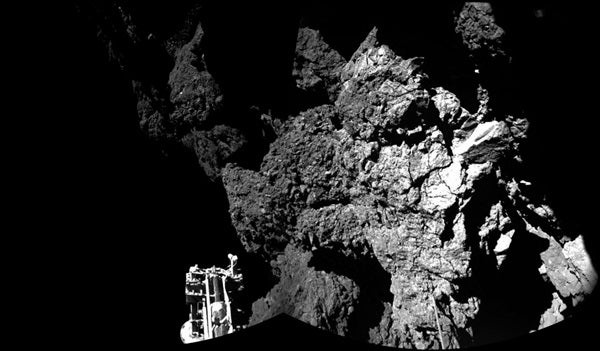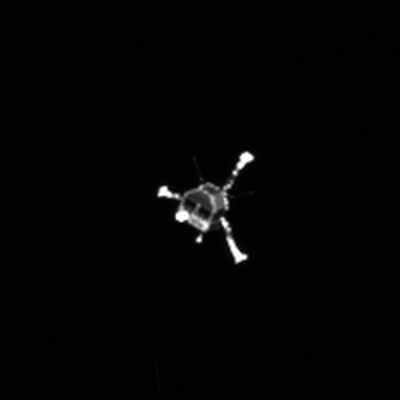It shows that the surface of the comet is covered by dust and debris ranging from millimeter to meter sizes.
The large block in the top right corner is 16 feet (5m) in size. In the same corner the structure of the Philae landing gear is visible.
Now more than 24 hours past its separation from the Rosetta spacecraft, the Philae lander finds itself in an interesting position on the surface of Comet 67P/Churuymov-Gerasimenko. According to mission scientists, the probe officially landed three times on the comet: an initial touchdown, a first rebound of almost two hours, which likely caused Philae to reach up to 0.6 mile (1 kilometer) above 67P’s surface, and a second jump that lasted about seven minutes.
According to John-Pierre Bibring, principal investigator for Philae’s CIVA instrument, scientists don’t know exactly where Philae is at the moment, but data suggest the lander is likely on the other side of a crater at the head of Comet 67P opposite where Philae initially touched down. Initial photos from the CIVA instrument also indicate that the lander is in the shadow of a cliff and possibly positioned almost vertically, with one foot in open space and the other two on the ground.
“It was a huge leap,” said Stephan Ulamec, Philae lander manager at the DLR German Aerospace Center. “We may be in the rim of the crater. That might explain the bizarre orientation.”
At the moment, though, Philae continues to take important data with some of its instruments, and its images are providing valuable information as well. These instruments are currently being powered by batteries, but the lander was designed to rely on solar energy to operate for an extended amount of time. Due to the shadow Philae appears to be in, mission scientists are calculating what this means for the near future. As of now, according to Ulamec, the team is hesitant to do any mechanical actuation, including using Philae’s drill, because they don’t know how any movement would affect the positioning of the lander.












